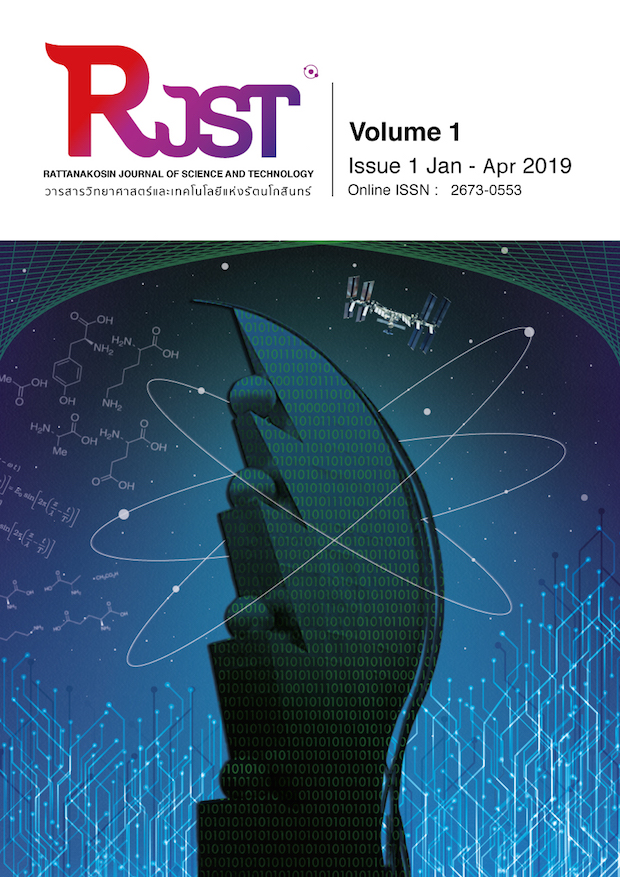การศึกษารูปแบบความเสียหาย และการดูดซับพลังงานจลน์ของผนังคอนกรีตเสริมเส้นใยเหล็กกันกระสุน เมื่อถูกยิงด้วยกระสุนขนาด .44 Magnum
Main Article Content
บทคัดย่อ
งานวิจัยนี้เป็นการศึกษารูปแบบความเสียหาย การสูญเสียน้ำหนัก และการดูดซับพลังงานจลน์ของผนังคอนกรีตเสริมเส้นใยเหล็ก เมื่อถูกยิงด้วยกระสุน .44 Magnum ในขั้นตอนการทดสอบทำการติดตั้งอุปกรณ์วัดความเร็วด้านหน้าและด้านหลังของแผ่นทดสอบที่ระยะห่าง 2.5 และ 0.3 เมตร ตามลำดับ จากนั้นผนังถูกยิงด้วยกระสุนปืนเข้าที่กึ่งกลาง โดยผนังที่ใช้มีการแปรผันปริมาณเส้นใยเหล็กเท่ากับ 1%, 2% และ 3% โดยปริมาตร ที่ความหนาแตกต่างกัน จากการทดสอบพบว่า รูปแบบการวิบัติของผนังคอนกรีตจะมีลักษณะแตกต่างกันไปขึ้นอยู่กับความหนาและปริมาณเส้นใยเหล็ก โดยรูปแบบการวิบัติที่พบทั่วไป ได้แก่ เกิดการทะลุผ่าน (Perforation), การกะเทาะที่ผิวหน้า (Scabbing), กะเทาะออกที่ด้านหลัง (Spalling), รอยร้าว (Crack) และไม่เกิดความเสียหาย (No damage)
Article Details
ข้อความภายในบทความที่ตีพิมพ์ในวารสารทั้งหมด รวมถึงรูปภาพประกอบ ตาราง เป็นลิขสิทธิ์ของมหาวิทยาลัยเทคโนโลยีราชมงคลรัตนโกสินทร์ การนำเนื้อหา ข้อความหรือข้อคิดเห็น รูปภาพ ตาราง ของบทความไปจัดพิมพ์เผยแพร่ในรูปแบบต่าง ๆ เพื่อใช้ประโยชน์ในเชิงพาณิชย์ ต้องได้รับอนุญาตจากกองบรรณาธิการวารสารอย่างเป็นลายลักษณ์อักษร
มหาวิทยาลัยฯ อนุญาตให้สามารถนำไฟล์บทความไปใช้ประโยชน์และเผยแพร่ต่อได้ โดยต้องแสดงที่มาจากวารสารและไม่ใช้เพื่อการค้า
ข้อความที่ปรากฏในบทความในวารสารเป็นความคิดเห็นส่วนตัวของผู้เขียนแต่ละท่านไม่เกี่ยวข้องกับราชวิทยาลัยจุฬาภรณ์ และบุคลากร คณาจารย์ท่านอื่น ๆ ในมหาวิทยาลัยฯแต่อย่างใด ความรับผิดชอบองค์ประกอบทั้งหมดของบทความแต่ละเรื่องเป็นของผู้เขียนแต่ละท่าน หากมีความผิดพลาดใด ๆ ผู้เขียนแต่ละท่านจะรับผิดชอบบทความของตนเอง ตลอดจนความรับผิดชอบด้านเนื้อหาและการตรวจร่างบทความเป็นของผู้เขียน ไม่เกี่ยวข้องกับกองบรรณาธิการ
เอกสารอ้างอิง
[2] Sukontasukkul P., 2001, Impact Behavior of Concrete under Multiaxial Loading, PhD Thesis, University of British Columbia.
[3] Mindess, S., Young, SF., Darwin, D, 2002, Concrete 2nd Edition, Prentice Hall.
[4] Sukontasukkul, P., Mindess, S., and Banthia, N., June 2002, Penetration Resistance of Hybrid Fibre Reinforced Concrete under Low Velocity Impact Loading, Annual Conference of the Canadian Society for Civil Engineering, Montreal, Montreal, Quebec, Canada.
[5] M. Nili , A.H. Ghorbankhani , A. AlaviNia , M. Zolfaghari, 2016, Assessing the impact strength of steel fibre-reinforced concrete under quasi-static and high velocity dynamic impacts, Construction and Building Materials 107: 264-271.
[6] Radoslav Sovjak, Tomas Vavriník, Jan Zatloukal, Petr Maca , Tomas Micunek , Michal Frydrýn, 2015, Resistance of slim UHPFRC targets to projectile impact using in-service bullets, International Journal of Impact Engineering 76 : 166-177.
[7] Piti Sukontasukkul, Sittisak Jamnam, Kittipoom Rodsin, Nemkumar Banthia, 2013, Use of rubberized concrete as a cushion layer in bulletproof fiber reinforced concrete panels , Construction and Building Materials 41 : 801-811.
[8] ปิยพงษ์ สุวรรณมณีโชติ และคณะ, 2016, Development of high performance concrete for bulletproof wall panel application, Naresuan University Engineering Journal.


